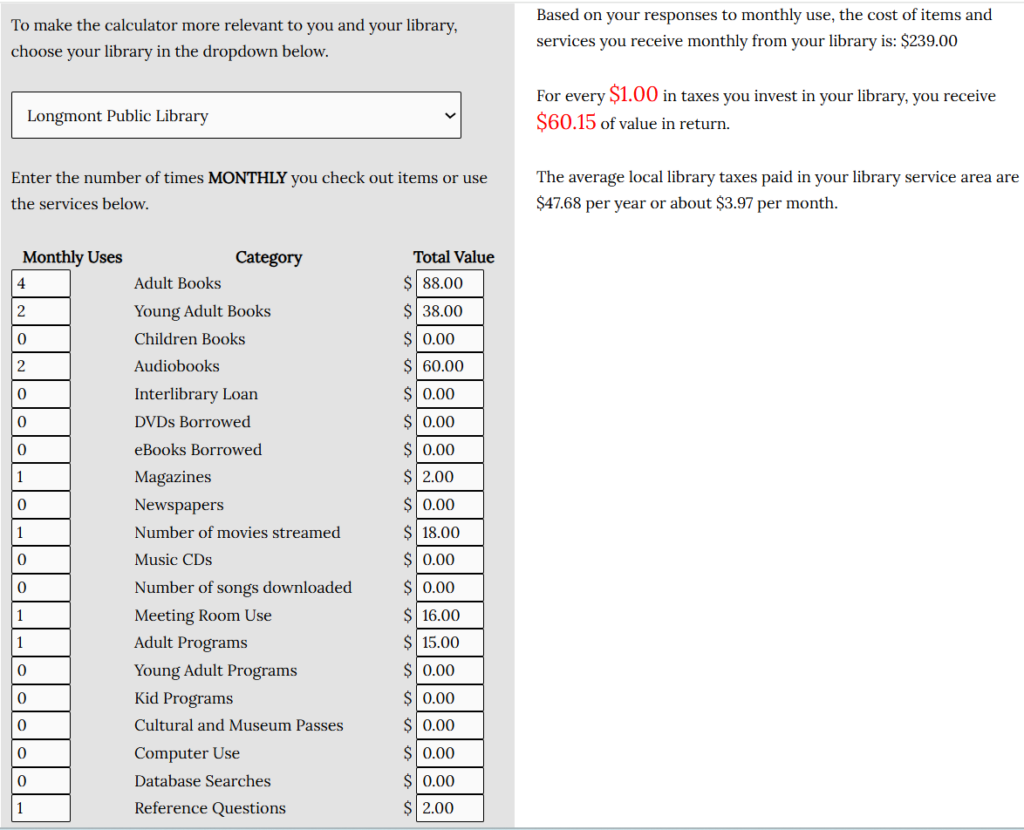How do you begin to put a price tag on a library and its services? While many of us may agree that access to a library’s community space, and the stories, information, and resources within is invaluable, it is also powerful to specify just how much worth libraries bring to their communities.
Whenever a patron borrows materials, uses a resource at the library, or attends programming, they are gaining value from their library. We may think of these as “free” services, but people who live in a library system’s service area invest in their library by paying the local taxes that help keep their library running. You can check out the blog post, A Search Through Local Revenue Sources, for a recap of the many different ways libraries are funded or check out this dashboard to find the latest data on each Colorado library system’s revenue. Selecting the radio button “Revenue Sources” in this dashboard will show the breakdown of local, state, federal, and other funding sources.
To show stakeholders and community members just how much value, in monetary terms, they receive in exchange for their contributions to their local library, Library Research Service (LRS) provides a return on investment (ROI) calculator, which makes its calculations based on an individual’s usage of the library. Recently, LRS completed a thorough reboot of the calculator to include updated approximations based on recent research, so anyone can find out approximately just how much value they get for every $1 dollar they invest into their library. Below you’ll find some advice for using this calculator, and we strongly encourage everyone to check out this new and improved Library Value Calculator on lrs.org for themselves.
Caveats to Consider
Of course, though carefully crafted to calculate meaningful estimates based on the latest data available, this Library Value Calculator can only generate ballpark figures. As also stated on the calculator itself, it should not be used as an in-depth analysis of the value of a library. The calculations provided are based on estimated assigned values for different services that patrons may use at their library, but there are many factors not taken into account such as collection size or ease of access to the library space. Our Library Value Calculator takes just one of the many possible approaches to calculating a library’s value to an individual. Multiple resources exist outside of LRS that take different approaches to tackling this crucial question, such as this Library Contribution to Social Wellbeing Calculator which brings a different perspective.
To use our Library Value Calculator you only need to enter two things: the Colorado library system that you use (selected from a dropdown) and the number of times you use each type of library service in a month. We’ve come up with a list of 20 of the most common services and items available to check out at a library, but depending on your library usage, many of these may remain at 0. There are, of course, unique services your library may offer that didn’t make this list, such as different makerspace tools, which is another reason these calculations may not fully encompass the monetary value a library gives to its patrons. Additionally, not every adult book within a library is worth the exact same amount (estimated at $22.00) nor is every meeting room reservation (estimated at $16.00 per use). You can investigate how we arrived at these numbers through this spreadsheet.
An Example Calculation
In Figure A below, we’ve used the Library Value Calculator to calculate the return on investment that a Longmont resident with moderate usage of their library may receive.

Within a month this person checked out six books from their library (four adult and two young adult), borrowed two audiobooks, read one magazine, streamed one movie, used a meeting room one time, attended one adult program, and asked one reference question. All in all, it is estimated that this patron receives $60.15 for every $1.00 he or she invests in the library. If a library system with higher local revenue per capita is selected, this value will be below $60.15 and vice versa if a library with lower local revenue per capita is selected. As stated above on the calculator, a Longmont resident pays an average of $47.68 annually to their local library, or about $3.97 per month. The Total Value column shows the value assigned to each of these services multiplied by the number of times that service was used, which adds up to a total value of $239.00 received from the library throughout this month. Divide this by the almost four dollars invested for the month, and this patron has a return on investment of $60.15 for each dollar spent.
Investing for the Future
As you use this calculator and discover the return you, and maybe also your family or friends, receive from the library, it is important to also remember the value of the library space as a whole: It’s a public, community-owned place where all are welcome and there is no admission fee. Although it’s easy to think of libraries then as “free” spaces that provide “free” resources, this can also make it easier to overlook the funds that are needed to keep a library running and bring those awesome resources to communities. Libraries are investments that communities choose to continue making because of what they give back to the community through education and information access, entertainment, community building, meeting spaces, access to technology and internet connectivity, an endless number of stories, and much, much more.
LRS’s Colorado Public Library Data Users Group (DUG) mailing list provides instructions on data analysis and visualization, LRS news, and PLAR updates. To receive posts via email, please complete this form.